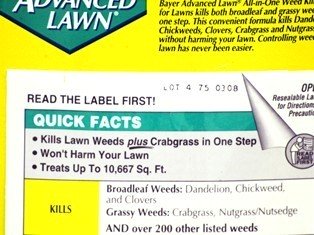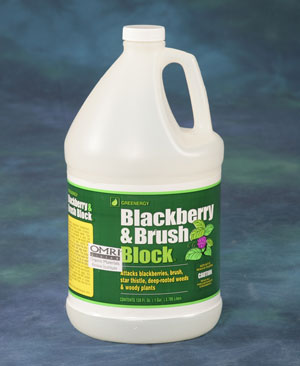Organic Herbicides
A small group of Organic Herbicides exist for home use. Nature can't produce a beautiful lawn by itself. We need help and herbicides are simply aids that help us achieve the results we want.
Weed control products can be organic, as described on this page, or click here for non-organic chemical formulations. Currently, this second group makes up the majority of pesticide products.
The choice to use a herbicide, organic herbicide or chemical doesn't always have to be a last resort, if we use them wisely. But if we decide to use them, they should be used responsibly. While organic herbicides can increase our safety, the number of products are still limited.
Keep in mind that "Organic" doesn't always mean "safe". Some organics are very toxic. Even with some organic pesticide products, our safety and the safety of our families and environment can be put at risk if we misuse them.
When used correctly and according to the label, they can offer a safe and effective means of achieving our goals in weed control. Click on the link if you would like more information to better understand the Effects of Pesticides on the Environment.
How Organic Herbicides are Catagorized
Weed control products can basically be divided into two catagories: "Contact" and "Systemic".
The word "Contact" means it kills the parts of the plant it touches. Generally, that means everything above the soil line. Depending on the product, it can work very fast with a knockdown (drooping or falling over) in one day or less. For some plants, that is all that is needed to kill them.
However, for others, contact only is not enough. Plants that spread by stolons, rhizomes, tubers, or if they can regrow from root fragments, such as Dandelions, will continue to be a problem.
Again, the benefit of contact herbicides is their so-called "quick kill" effect. Popular advertisements talk of its power to "knockdown in one day". However, for most weeds, systemic products are the better choice. Some herbicides will contain a mixture of the two, both Contact and Systemic, for better control. It appears to the customer that it is working faster.
The word "Systemic" means the plant absorbs the chemical and transports it internally throughout the plant. It usually doesn't have the quick "knockdown" effect of the contact varieties, but the entire weed will be killed, roots and all.
The speed of chemical movement in the plant is largely dependent on soil and air temperature. Mode of action is also an important factor in how fast it works.
A chemical sprayed in early spring may take a couple weeks longer to work than the same chemical sprayed in mid-summer. If the "Mode of Action" is to suppress an essential hormone (a common mode of action) then it can take from a week to several weeks before seeing any results.
If you decide to use a herbicide or any other lawn chemical, there are certain things you must do before the bottle is opened. Below is a partial list of important safety considerations:
Important Things We Must Do First
- Always read the label completely before opening the container.
- Make sure you have all the personal protective equipment (PPE) listed on the label before opening the container.
- Make sure the label lists the target weeds you want to control.
- Make sure it is not too windy to spray. If so, wait until weather conditions are right.
For complete information on pesticide safety, please read the Using Pesticides Safely page. It is loaded with valuable information to keep you, your family, and the environment safe.
Note: The following list of organic herbicides is not an exhaustive list. Additionally, because they are listed here does not constitute an endorsement. Instead, these are common and effective products labeled for home use in most states. Some products may not be legally used or sold in certain states or may be restricted only to licensed applicators. Be sure to check with your local county extension office if you need help making a selection.
Organic Herbicides
Acetic Acid (Vinegar)
Vinegar contains Acetic Acid that burns the leaves and stems. Vinegar, is a non-selective, contact weed killer. This means it will kill or harm the above ground plant tissue it touches, but will not translocate (travel internally throughout the plant) into the roots. Plants that regenerate from roots, tubers, or rhizomes will not be controlled. However, you should know that the vinegar you buy at the grocery store contains only about 5% acetic acid. Studies have shown that 5% is insufficient and may not control some weeds effectively. The result is that most weeds will come back. If you find that to be the case, there are a few commercial vinegar products available that may offer better results.
Vinegar labeled as a weed control product, in most cases, must be registered with the EPA. Many concentrated solutions are as high as 50% acetic acid and must be diluted before spraying. These are available only to licensed applicators. However, a few commercial products are available for home use without a license. They also combine citric acid for added effect.
Trade Names
- Nature’s Glory - Grass and Weed Killer 6.25% acetic acid
- Greenergy's Blackberry and Brush Block 7.0% acetic acid
- St. Gabriel Labs Fast Acting Burnout RTU 6.25% acetic acid
Be advised that these products may not be available or legal to use in all states. Check with your local county extension office for advice on what is legal to use where you live.
Corn Gluten Meal (CGM)
CGM: An Organic Herbicide Preemergent
Corn gluten meal is a by-product of corn processing and milling. It is a natural preemergent and is used as a substitute for the chemical varieties. The preemergence effect of Corn Gluten Meal was discovered by accident by Dr. Nick Christians. Dr. Christians is a professor at the University of Iowa and one of the world’s leading turf scientists. While using corn gluten meal in an unrelated experiment, he discovered its preemergent qualities.
How CGM Works
Corn Gluten Meal (CGM)is a fertilizer containing 9% slow release Nitrogen and is a natural preemergent for grassy and broadleaf weeds. The Nitrogen needs of the grass must be taken into account when determining the amount of material to apply.
As a preemergent, it works by absorbing surface moisture needed by tiny germinating seeds. Established plants have developed root systems and are not affected since they can reach water below the effects of the CGM.
CGM is sometimes advertised as post-emergent weed killer. It is important to know that corn gluten meal has no weed killing properties, except as a preemergent.
The rate of application is from 10 to 30 lbs/1000 sq. ft. After applying, it needs to be watered in and followed by a drying period. This drying period is necessary for corn gluten’s desiccating effect. If you live in the northwestern U.S. or have an unusually wet spring, you may not get the results you hoped for.
In today's economy prices for CGM varies greatly, so shop around for the best price. If you need to have it shipped to you, the shipping cost may be more than the product itself. Don’t overlook any local grain mills that specialize in corn products.
If you are using Corn Gluten Meal as an organic herbicide and as part of fertility program, then remember that CGM has about 9% slow release nitrogen.
Organic Fungicide and Prebiotic Soil Nutrient Booster
One way to cut down on Chemical Fungicides is using Turf Formula or Foliar Blend. This is not a sales pitch. When Foliar Blend is used on rice, for example, it totally removed the need for certain Fungicides. When used on grass, I haven't had to use any fungicides at all on my grass or apple trees.
It works by increasing the naturally occurring microbes in the soil by 5000% in 72 hours, some of these microbes feed upon pathogenic microbes and nematodes. It works incredibly fast and is all natural, safe for people and pets. Just take a look at their pages on our website.
Turf Formula Prebiotic and BiostimulantFoliar Blend Prebiotic and Biostimulant
Understanding Chemical Herbicides
Many weeds are difficult to control. Many chemical herbicides offer a safe and effective solution when used according to the label. Find out how they work and what products are available.
Effects of Pesticides on the Environment
We all need to be aware of our environment. If you would like some helpful information on how pesticides can effect the environment, click on the link above.
Using Spray Adjuvants to Increase Pesticide Effectiveness
Spray Adjuvants are added to herbicides to increase their safety and effectiveness. Find out how adding a sticker and spreader to your herbicide can help it to work better while using less product.
Zoysia Grass and 2,4-D Concerns
If you have a zoysia grass lawn, you know how beautiful and hardy it is. However, 2,4-D herbicide can harm it during a short period in spring. Click here to learn about weed control for zoysia lawns.
Organic Herbicides back to Lawn Care Academy Home





